The Yyza virus, categorized as a ransomware infection, is a member of the STOP family. This malware is notorious for its malicious activities involving the encryption of files. Upon infiltrating a computer, the Yyza virus specifically targets a range of file types, including photos, videos, documents, and more. It alters the structure of these files and appends the “.yyza” extension to each one, rendering them inaccessible without the requisite decryption key.
Yyza Virus Overview
Yyza
🤔 Yyza malware can be classified as ransomware that belongs to the DJVU/STOP ransomware family. Its main target is to cipher your files. Then, this ransomware asks its victims to pay the ransom – ($490 – $980) in Bitcoin.
The Yyza virus is a type of malware that encrypts your files and makes you pay for their restoration. This ransomware encrypts different file types. ciphered files can be identified by a distinct “.yyza” extension. The affected files become inaccessible and unusable.
Subsequently, the ransomware demands a file decryption payment in Bitcoin from the victims, ranging from $490 to $980. In all cases, a ransom text file is named as “_readme.txt“.
Yyza Ransomware operates by Salsa20 encryption algorithms to cipher the files. Since Yyza virus employs such a strong ciphering method, it becomes quite hard, if not impossible, to find the decryption key without the assistance of the attackers.
Once Yyza malware finishes the encryption, it shows a ransom note to the user, demanding a ransom payment for the decryption key. The ransom note provides instructions on how to make the payment and often includes threats of permanent data loss or increased ransom amounts if the ransom is not paid within a specified timeframe.
I have made an all-encompassing list of potential solutions, advice, and methods to disable the Yyza virus and recover access to your files. In some cases, it may be possible to restore your files, but sometimes, it may be impossible.
📌 Important Note!
It is critical to note that paying off the bill does not guarantee the successful recovery of your files. The individuals who stand behind the Yyza virus are not trustworthy. There have been instances where people have paid the ransom, only to be denied by the cybercriminals with the decryption key provision.
Yyza employs a unique key for each victim, with one exception:
- If Yyza fails to connect the command and control server (C&C) before starting the encryption process, it it uses offline keys as a fallback option. An offline key is not unique and is the same for all users, allowing for the decryption of files encrypted by the ransomware.
The Yyza virus bears resemblance to other DJVU ransomware samples like Tasa, Yytw, Wspn, and Taoy. This virus encrypts a wide range of common file types and appends its distinct “.yyza” extension to all files. For instance, a file named “1.jpg” would be altered to “1.jpg.yyza” and “2.png” to “2.png.yyza“.
After successful encryption, malware creates a special text file named “_readme.txt” and places it in every folder containing the encrypted files. It as well adds the readme file to the desktop, so the victim will not miss its appearance even without opening folders.
The image below provides a visual representation of files with the “yyza” extension:
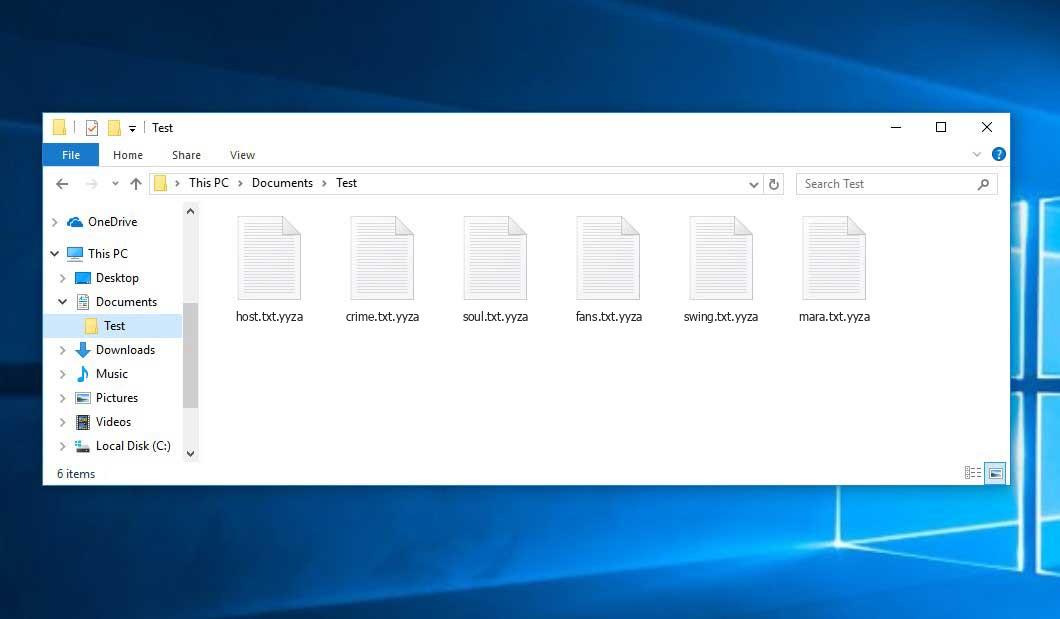
Encrypted Files by STOP/DJVU Ransomware
| Name | Yyza Virus |
| Ransomware family1 | DJVU/STOP2 ransomware |
| Extension | .yyza |
| Ransomware note | _readme.txt |
| Ransom | From $490 to $980 (in Bitcoins) |
| Contact | [email protected], [email protected] |
| Detection | Backdoor:Win32/Kelihos.F, TrojanDropper:Win32/Injector.A!MTB, MSIL/GenKryptik.GMLZ |
| Symptoms |
|
| Fix Tool | To remove possible malware infections, scan your PC: 6-day free trial available. |
This message asking payment is for restore files via decryption key:
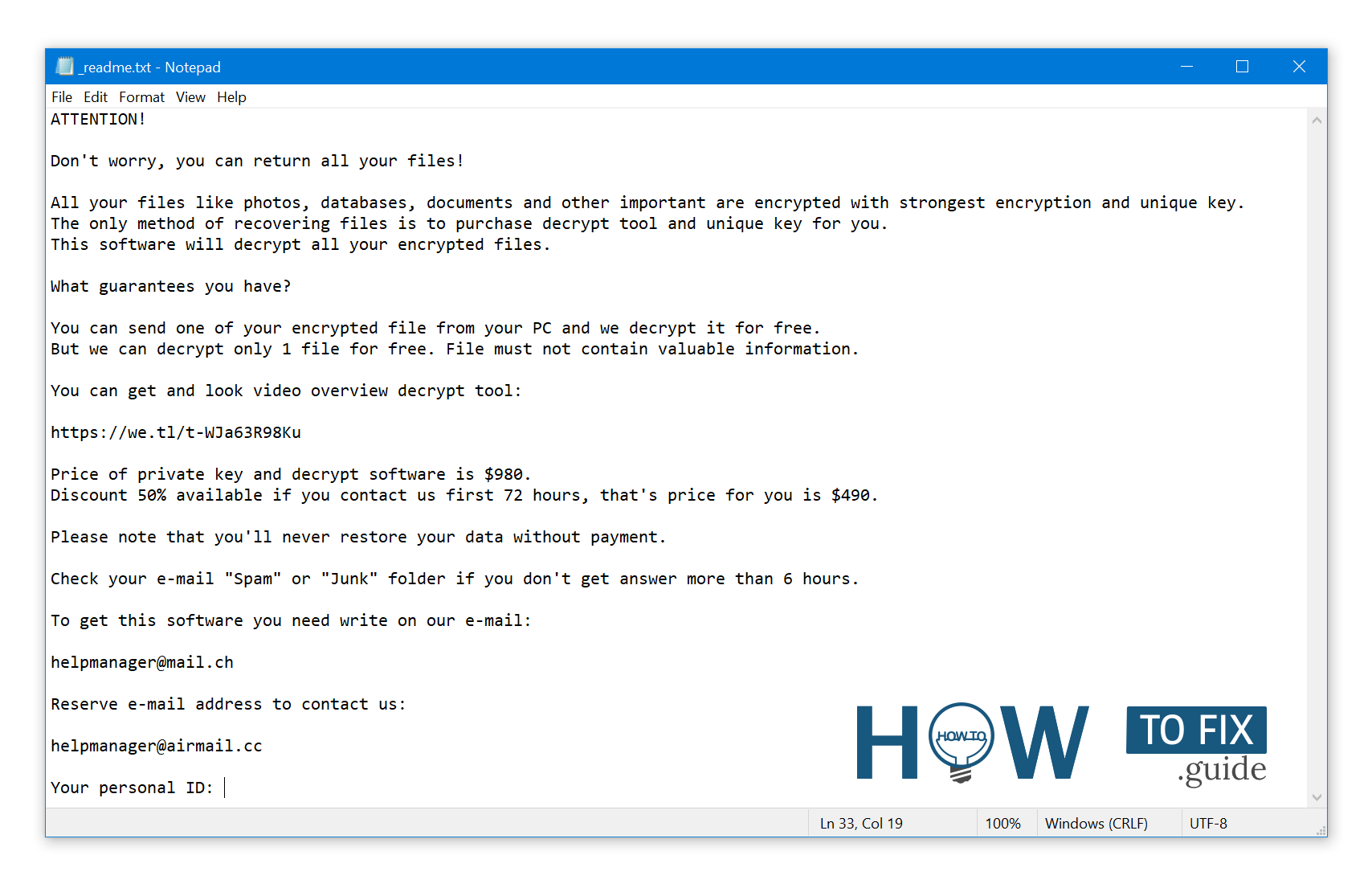
_readme.txt (STOP/DJVU Ransomware) – The scary warning demanding users to pay off the ransom to unlock the encoded data contains these exasperating warnings.
The Yyza ransomware executes a series of actions to carry out specific functions on a victim’s computer actively. One of the initial actions involves launching the deceptive process named winupdate.exe, which presents a counterfeit Windows update prompt during the attack. This ruse aims to mislead the victim into believing that their computer’s sluggishness is due to a Windows update.
Simultaneously, the ransomware initiates another process with a randomly generated name consisting of four characters. This process scans the victim’s PC for target files and encrypts them. Subsequently, the ransomware eliminates Volume Shadow Copies from the system using the following CMD command:
vssadmin.exe Delete Shadows /All /Quiet
Once removed, the ability to restore the computer to its previous state becomes exceedingly challenging, rendering the use of System Restore Points virtually futile. The predicament arises from the ransomware operators’ deliberate elimination of built-in Windows mechanisms that could facilitate free file recovery for the victim. Furthermore, the perpetrators tamper with the Windows HOSTS file by appending a list of domains and redirecting them to the localhost IP. Consequently, attempting to access any of the blacklisted websites results in a DNS_PROBE_FINISHED_NXDOMAIN error.
We have observed that the ransomware makes a deliberate effort to restrict access to websites that offer diverse how-to guides for computer users. Evidently, by imposing limitations on specific domains, the malicious actors aim to impede the victim’s access to pertinent and helpful information concerning ransomware attacks. This malware also deposits two text files on the victim’s computer, containing crucial details about the attack – the victim’s public encryption key and personal ID. These files are denoted as bowsakkdestx.txt and PersonalID.txt.
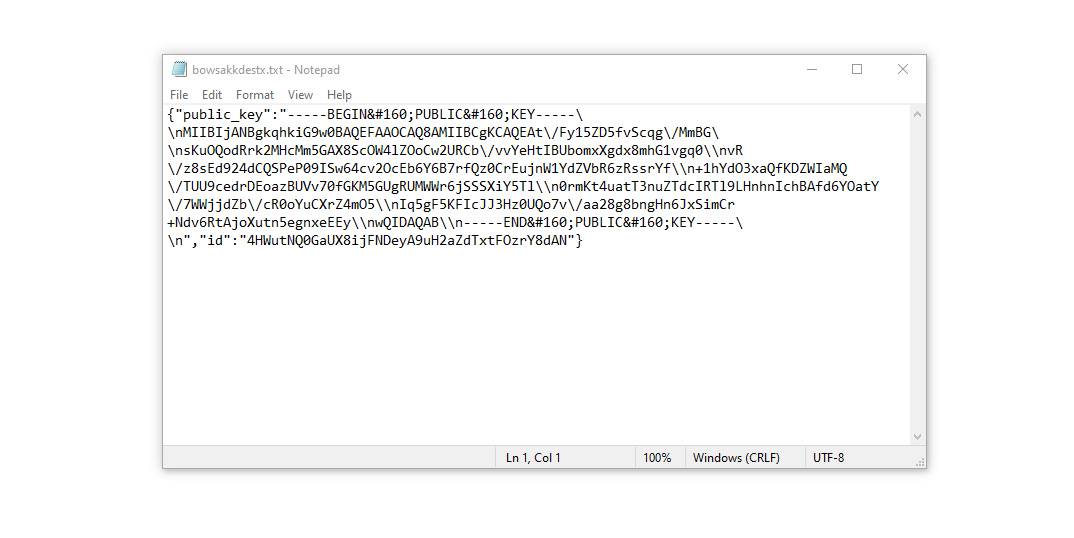
Despite these modifications, the malware remains relentless. Variants of the STOP/DJVU ransomware strain exhibit a tendency to install the Vidar password-stealing Trojan onto compromised systems. This insidious threat boasts a wide array of capabilities, including:
- Executing malicious software on the victim’s computer to extract sensitive data.
- Unauthorized acquisition of login credentials for accounts on platforms such as Steam, Telegram, and Skype.
- Covert manipulation and inspection of files on the victim’s computer, operating unbeknownst to them.
- Pilfering cryptocurrency wallets stored on the victim’s system.
- Granting hackers remote control over the victim’s computer, facilitating a range of malicious activities.
- Extraction of sensitive information, encompassing browser cookies, stored passwords, and browsing history.
The cryptographic algorithm employed by the STOP/Djvu ransomware is AES-256. Consequently, if your data has been encrypted using an online decryption key, the prospects of restoring your files without succumbing to the ransom demands are notably slim. The crux of the matter is that this decryption key is distinctive for each victim, and deciphering it entails an exceedingly substantial investment of time.
Securing the online decryption key through alternative means is also an exceedingly arduous task. This key is safeguarded on a server under the control of the hackers who propagated the Yyza infection. To acquire the unlocking key, a payment of $980 is stipulated. For the payment particulars, victims are instructed to establish contact with the hackers via email ([email protected]).
The message by the ransomware states the following information:
ATTENTION! Don't worry, you can return all your files! All your files like photos, databases, documents and other important are encrypted with strongest encryption and unique key. The only method of recovering files is to purchase decrypt tool and unique key for you. This software will decrypt all your encrypted files. What guarantees you have? You can send one of your encrypted file from your PC and we decrypt it for free. But we can decrypt only 1 file for free. File must not contain valuable information. You can get and look video overview decrypt tool: https://we.tl/t-WJa63R98Ku Price of private key and decrypt software is $980. Discount 50% available if you contact us first 72 hours, that's price for you is $490. Please note that you'll never restore your data without payment. Check your e-mail "Spam" or "Junk" folder if you don't get answer more than 6 hours. To get this software you need write on our e-mail: [email protected] Reserve e-mail address to contact us: [email protected] Your personal ID: XXXXXXXXXXXXXXXXXXXXXXXXXXXXXXX
Do not pay the ransom!
Please, try to use the available backups, or Decrypter tool
The _readme.txt file also indicates that the user must establish contact with the hackers’ representatives within 72 hours following the attack. Adhering to this 72-hour stipulation results in a 50% discount being granted by the hackers. Consequently, the ransom sum is reduced to $490.
However, it is strongly advised to refrain from capitulating to the ransom demands. I highly recommend that you avoid engaging with these fraudulent individuals and abstain from making any payment. An exceedingly effective course of action to recover the lost data involves utilizing existing backups or employing the Decrypter tool provided by Emsisoft.
The hallmark of these viruses lies in their utilization of a similar sequence of actions to generate the unique decryption key necessary for restoring the encrypted data. As a result, unless the ransomware is still in the developmental phase or exhibits obscure vulnerabilities, manual data recovery remains an unattainable endeavor. The sole recourse to avert the loss of invaluable data is to maintain regular backups of critical files.
It’s important to note that even if you diligently maintain such backups, they should be stored in a dedicated location separate from your primary workstation. For instance, the backup could be stored on a USB flash drive or another external hard drive storage solution. Alternatively, you may opt for the assistance of online (cloud) data storage.
Needless to say, storing your backup on your primary device could render it susceptible to encryption alongside other data. Thus, preserving the backup on your main computer is unquestionably ill-advised.
How I was infected?
Ransomware has a various methods to built into your system. But it doesn’t really matter what way had place in your case.

Ransomware attack following a successful phishing attempt.
Nevertheless, the following are the typical vulnerabilities through which it could infiltrate your PC:
- Utilizing online free hosting resources as a concealed means of disseminating the virus.
- Concealing the virus installer within various applications, particularly those distributed as freeware or shareware.
- Propagating the virus via spam emails containing misleading links that lead to its installation.
- Acquiring pirated software from illegal peer-to-peer (P2P) sources, thereby exposing users to potential malware hazards.
Instances have arisen in which the Yyza virus has been camouflaged as a legitimate tool, such as messages insisting on executing a browser update or an ostensibly crucial codec for online media playback. This serves as the modus operandi for certain online deceptions aimed at coercing you into manually installing the ransomware, effectively involving you directly in this process.
Undoubtedly, the fabricated update alert will not disclose that you are inadvertently introducing the virus. Instead, this procedure will be concealed beneath an alert that asserts the necessity to install an urgent security update or some questionable program.
Without question, cracked applications also harbor potential harm. Engaging in P2P activities is not only illegal but can also lead to the introduction of severe malware, including the Yyza ransomware.
In summary, what measures can you take to prevent the ransomware from infiltrating your system? Although there is no foolproof method to guarantee complete immunity from infection, there are certain recommendations I would like to offer to thwart the infiltration of Yyza. Vigilance during the installation of free software is paramount.
Always ensure you carefully review the additional offerings presented by the installer, apart from the primary free program. Exercise caution when dealing with suspicious email attachments. Refrain from executing files from unfamiliar senders. Of course, it’s imperative to keep your current anti-malware program consistently updated.
The malware operates in a covert manner. It won’t manifest openly in your list of available programs. Instead, it remains concealed beneath a malicious process that consistently operates in the background, initiating from the moment your computer is launched.
How To Remove Ransomware?
Remove Yyza Virus with Gridinsoft Anti-Malware
We have also been using this software on our systems ever since, and it has always been successful in detecting viruses. It has blocked the most common Ransomware as shown from our tests with the software, and we assure you that it can remove Yyza Virus as well as other malware hiding on your computer.

To use Gridinsoft for remove malicious threats, follow the steps below:
1. Begin by downloading Gridinsoft Anti-Malware, accessible via the blue button below or directly from the official website gridinsoft.com.
2.Once the Gridinsoft setup file (setup-gridinsoft-fix.exe) is downloaded, execute it by clicking on the file.

3.Follow the installation setup wizard's instructions diligently.

4. Access the "Scan Tab" on the application's start screen and launch a comprehensive "Full Scan" to examine your entire computer. This inclusive scan encompasses the memory, startup items, the registry, services, drivers, and all files, ensuring that it detects malware hidden in all possible locations.

Be patient, as the scan duration depends on the number of files and your computer's hardware capabilities. Use this time to relax or attend to other tasks.
5. Upon completion, Anti-Malware will present a detailed report containing all the detected malicious items and threats on your PC.

6. Select all the identified items from the report and confidently click the "Clean Now" button. This action will safely remove the malicious files from your computer, transferring them to the secure quarantine zone of the anti-malware program to prevent any further harmful actions.

8. If prompted, restart your computer to finalize the full system scan procedure. This step is crucial to ensure thorough removal of any remaining threats. After the restart, Gridinsoft Anti-Malware will open and display a message confirming the completion of the scan.
Remember Gridinsoft offers a 6-day free trial. This means you can take advantage of the trial period at no cost to experience the full benefits of the software and prevent any future malware infections on your system. Embrace this opportunity to fortify your computer's security without any financial commitment.
Trojan Killer for “Yyza Virus” removal on locked PC
In situations where it becomes impossible to download antivirus applications directly onto the infected computer due to malware blocking access to websites, an alternative solution is to utilize the Trojan Killer application.

There is a really little number of security tools that are able to be set up on the USB drives, and antiviruses that can do so in most cases require to obtain quite an expensive license. For this instance, I can recommend you to use another solution of GridinSoft - Trojan Killer Portable. It has a 14-days cost-free trial mode that offers the entire features of the paid version. This term will definitely be 100% enough to wipe malware out.
Trojan Killer is a valuable tool in your cybersecurity arsenal, helping you to effectively remove malware from infected computers. Now, we will walk you through the process of using Trojan Killer from a USB flash drive to scan and remove malware on an infected PC. Remember, always obtain permission to scan and remove malware from a computer that you do not own.
Step 1: Download & Install Trojan Killer on a Clean Computer:
1. Go to the official GridinSoft website (gridinsoft.com) and download Trojan Killer to a computer that is not infected.

2. Insert a USB flash drive into this computer.
3. Install Trojan Killer to the "removable drive" following the on-screen instructions.

4. Once the installation is complete, launch Trojan Killer.
Step 2: Update Signature Databases:
5. After launching Trojan Killer, ensure that your computer is connected to the Internet.
6. Click "Update" icon to download the latest signature databases, which will ensure the tool can detect the most recent threats.

Step 3: Scan the Infected PC:
7. Safely eject the USB flash drive from the clean computer.
8. Boot the infected computer to the Safe Mode.
9. Insert the USB flash drive.
10. Run tk.exe
11. Once the program is open, click on "Full Scan" to begin the malware scanning process.

Step 4: Remove Found Threats:
12. After the scan is complete, Trojan Killer will display a list of detected threats.

13. Click on "Cure PC!" to remove the identified malware from the infected PC.
14. Follow any additional on-screen prompts to complete the removal process.

Step 5: Restart Your Computer:
15. Once the threats are removed, click on "Restart PC" to reboot your computer.
16. Remove the USB flash drive from the infected computer.
Congratulations on effectively removing Yyza Virus and the concealed threats from your computer! You can now have peace of mind, knowing that they won't resurface again. Thanks to Gridinsoft's capabilities and commitment to cybersecurity, your system is now protected.
Video Guide
How To Decrypt .yyza Files?
How to restore big files?
Try deleting .yyza extension on a few big files and opening them. This malware has issues with large files encryption. Either the virus scanned and did not encrypt the file, or it bugged and did not add the filemarker. If your files are very large (2GB+), the latter is most likely. Please, let me know in comments if that will work for you.
The newest extensions released around the end of August 2019 after the criminals made changes. This includes Popn, Poaz, Wspn etc.
As a consequence of the changes made by the criminals, STOPDecrypter is no longer supported. It has been replaced with the Emsisoft Decryptor for STOP Djvu Ransomware developed by Emsisoft.
You can download free decryption tool here: Decryptor for STOP Djvu.
Download and run decryption tool.
Start downloading the decryption tool.
Make sure to launch the decryption utility as an administrator. You need to agree with the license terms that will come up. For this purpose, click on the “Yes” button:

As soon as you accept the license terms, the main decryptor user interface comes up:

Select folders for decryption.
Based on the default configurations, the decryptor will automatically choose the accessible directories in order to decrypt the currently reachable drives (the connected ones), including the network drives. You can select other locations with the “Add” button.
Decryptors usually propose several options considering the specific malware family. The present possible options are displayed in the Options tab and can be turned on or disabled there. You may discover a detailed list of the currently active Options below.
Click on the “Decrypt” button.
As soon as you add all the desired locations for decryption into the list, click on the “Decrypt” button in order to initiate the decryption procedure.
Note that the main screen may turn you to a status view, letting you know of the active process and the decryption statistics of your data:

The decryptor will notify you as soon as the decryption procedure is completed. If you need the report for your personal papers, you can save it by choosing the “Save log” button. Note that it is also possible to copy it directly to your clipboard and to paste it into emails or messages here if you need to do so.
The Emsisoft Decryptor might display different messages after a failed attempt to restore your files:
✓ Error: Unable to decrypt file with ID: [your ID]
✓ No key for New Variant online ID: [your ID]
Notice: this ID appears to be an online ID, decryption is impossible
✓ Result: No key for new variant offline ID: [example ID]
This ID appears be an offline ID. Decryption may be possible in the future.
It can take a few weeks or months until the decryption key gets found and uploaded to the decryptor. Please follow updates regarding the decryptable DJVU versions here.
✓ Remote name could not be resolved
How to Restore .yyza Files?
In some case ransomware is not doom for your files…
The Yyza ransomware encryption mechanism algoritm is next: it ciphers every file byte-by-byte, then saves a duplicate, deleting (not overriding!) the initial file. Hence, the information of the file placement on the disk drive is lost, but the original file is not deleted from the physical disk. The cell, or the sector where this file was kept, can still hold this file, but it is not listed by the file system and can be overwritten by data that has been loaded to this drive after the deletion.
This loophole, actually, allows you to restore your files using special software. There could be certain obstacles, especially when you use modern SSDs, but this gives you one more hope for file recovery.
Anyway, after realizing it was an online algorithm, it is impossible to retrieve my encrypted files. I also had my backup drive plugged in at the time of the virus, and this was also infected, or so I thought. Every folder within my backup drive had been infected and was encrypted. However, despite losing some important files, I retrieved almost 80% of my 2TB storage.
When I started going through the folders, I noticed the readme.txt ransom note in every folder. I opened some of the folders and found that all files that were not in a subfolder within that folder had been encrypted. However, I found a flaw and glimmer of hope when I went into the subfolders in other folders and found that these files had not been encrypted. Every folder within my c and d drives, including subfolders, had been encrypted, but this was not the case with the backup drive. Having subfolders created within a folder has saved 80% of my data.
As I said, I believe this to be only a small loophole on a backup drive. I’ve since found a further 10 % of my data on another hard drive on a different pc. So my advice is if you use a backup drive, create subfolders. I was lucky, I guess. But I was also unlucky that the virus hit as I was transferring some files from my backup.
Hopefully, this can help some other people in my situation.
Jamie NewlandRecovering your files with PhotoRec
PhotoRec is an free open-source program, which is originally created for data recovery from damaged disks, or for file retrieval in case if they are unintentionally deleted. However, with time flow, this program received the ability to retrieve the files of 400 different formats. Hence, it can be used for file restoration after the Yyza attack.
First, you need to download this app. It is 100% free, but the developer notifies that there is no guarantee that the files will be retrieved. PhotoRec is distributed in a pack with other tool of the same developer – TestDisk. The program archive will bear TestDisk name, but don’t worry – PhotoRec files are right inside.
To launch PhotoRec, find and open “qphotorec_win.exe” file. No installation is required – the program has all the files it need inside of the archive, hence, you can mount it on your USB drive, and try to help your friends/parents/anyone who has been attacked by Yyza ransomware.
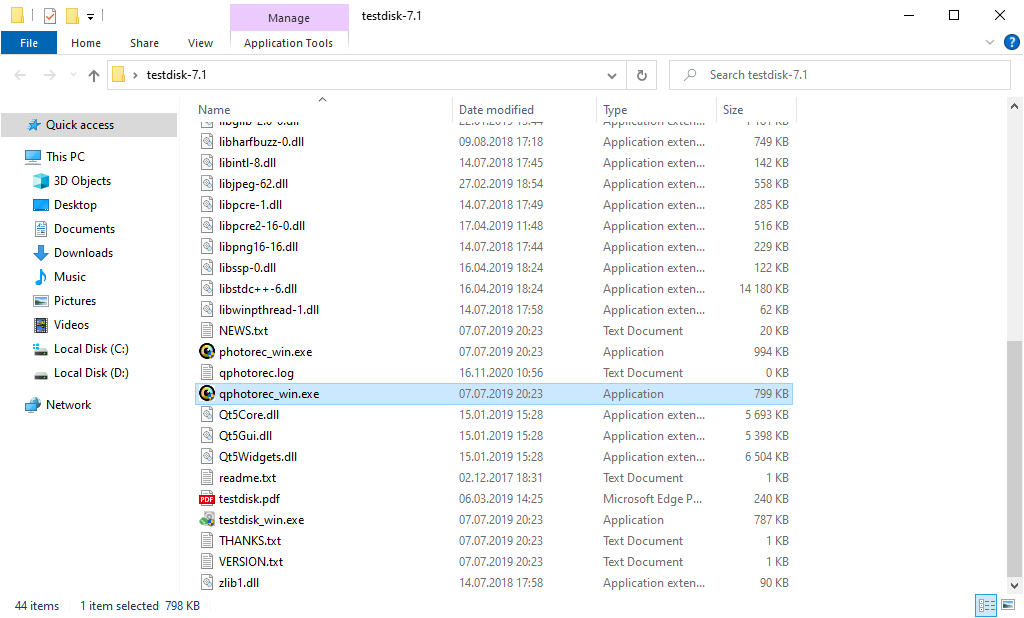
After the launch, you will observe the screen showing you the entire list of your disk spaces. However, this details are likely futile, because the required menu is placed a bit higher. Click this menu, then choose the disk which was attacked by ransomware.
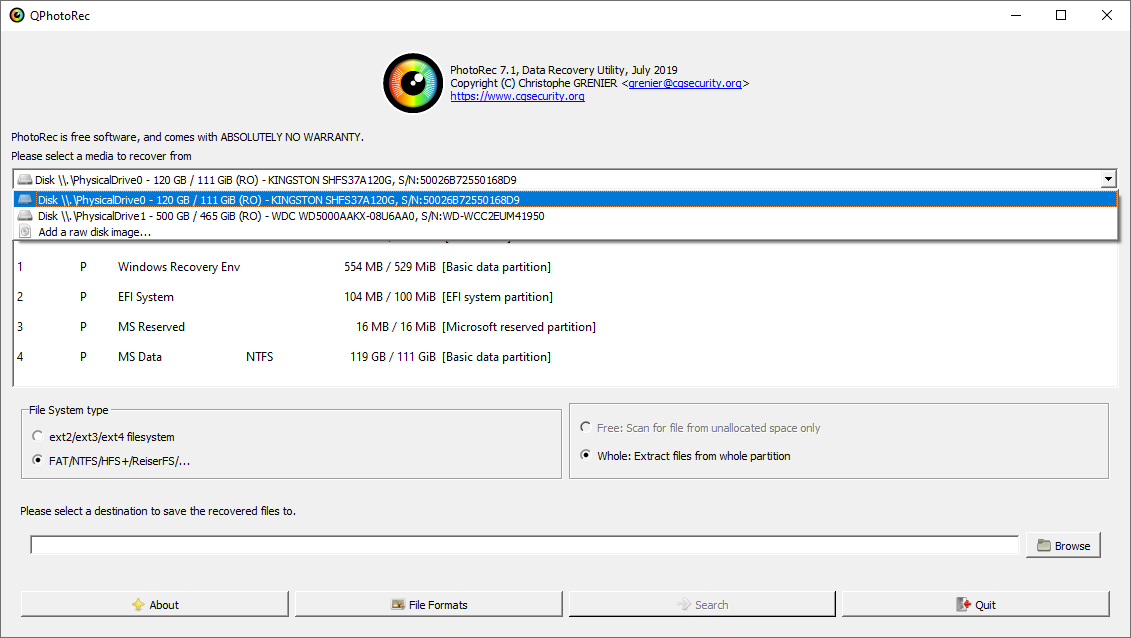
After selecting the disk, you need to select the destination folder for the restored files. This menu is located at the lower part of the PhotoRec window. The best decision is to export them on USB drive or any other type of removable disk.
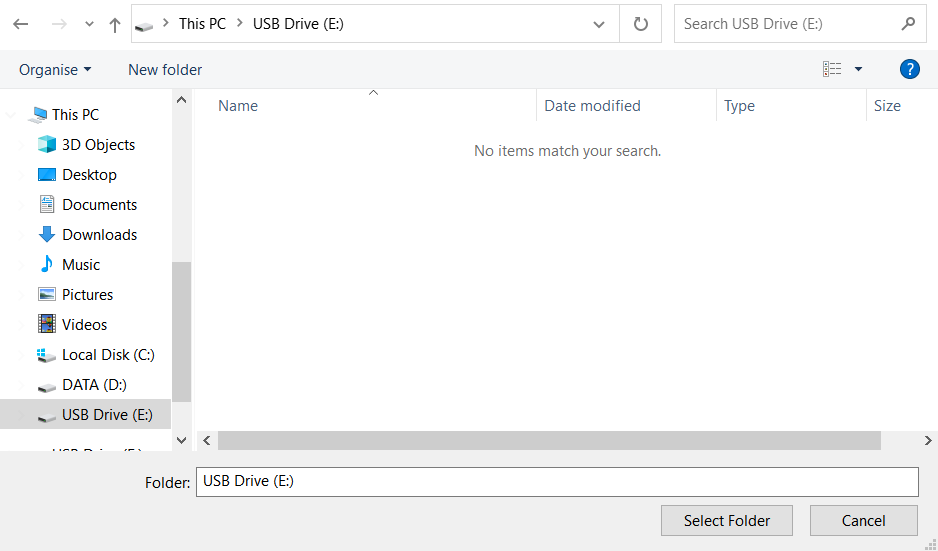
Then, you need to define the file formats. This setting is located at the bottom, too. As it was mentioned, PhotoRec can regain the files of about 400 different formats.
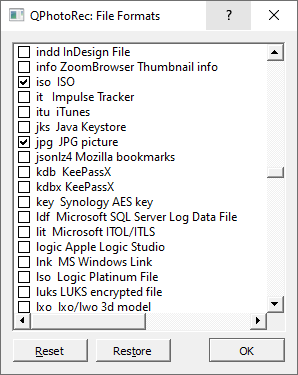
Finally, you can start files recovery by pressing the “Search” button. You will view the screen where the results of the scan and recovery are shown.
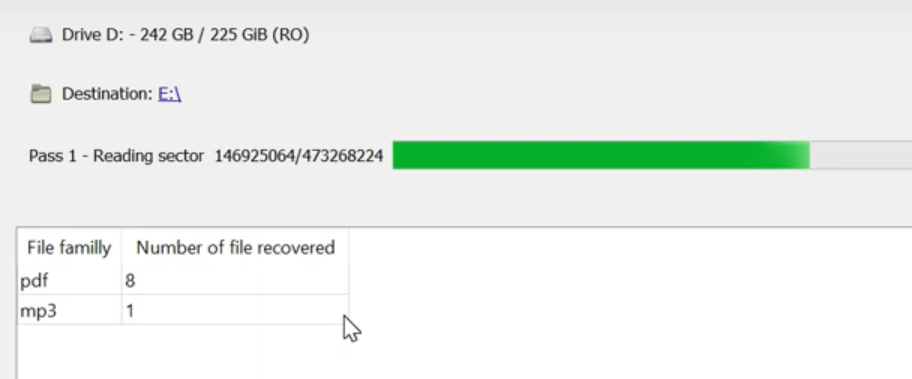
Yyza files recovery Video Guide.
Frequently Asked Questions
No way. These files are encrypted by ransomware. The contents of encrypted files are not available until they are decrypted.
If your data remained in the .yyza files are very valuable, then most likely you made a backup copy.
If not, then you can try to restore them through the system function – Restore Point.
All other methods will require patience.
Of course not. Your encrypted files do not pose a threat to the computer. What happened has already happened.
You need GridinSoft Anti-Malware to remove active system infections. The virus that encrypted your files is most likely still active and periodically runs a test for the ability to encrypt even more files. Also, these viruses install keyloggers and backdoors for further malicious actions (for example, theft of passwords, credit cards) often.
In this situation, you need to prepare the memory stick with a pre-installed Trojan Killer.
Have patience. You are infected with the new version of STOP/DJVU ransomware, and decryption keys have not yet been released. Follow the news on our website.
We will keep you posted on when new keys or new decryption programs appear.
The Yyza ransomware encrypts only the first 150KB of files. So MP3 files are rather large, some media players (Winamp for example) may be able to play the files, but – the first 3-5 seconds (the encrypted portion) will be missing.
You can try to find a copy of an original file that was encrypted:
- Files you downloaded from the Internet that were encrypted and you can download again to get the original.
- Pictures that you shared with family and friends that they can just send back to you.
- Photos that you uploaded on social media or cloud services like Carbonite, OneDrive, iDrive, Google Drive, etc
- Attachments in emails you sent or received and saved.
- Files on an older computer, flash drive, external drive, camera memory card, or iPhone where you transferred data to the infected computer.
If the guide doesn’t help you to remove infection, please download the GridinSoft Anti-Malware that I recommended. Do not forget to share your experience in solving the problem. Please leave a comment here! This can help other victims to understand they are not alone. And together we will find ways to deal with this issue.
I need your help to share this article.
It is your turn to help other people. I have written this guide to help people like you. You can use buttons below to share this on your favorite social media Facebook, Twitter, or Reddit.
Brendan SmithHow To Restore & Decrypt .YYZA Files?
Name: YYZA Ransomware
Description: The YYZA Virus belongs to the STOP/DJVU family of ransomware infections. This malicious software encrypts various file types, including videos, photos, and documents, which become identifiable by a distinct yyza extension. As a result, the affected files become inaccessible and unusable. Subsequently, the YYZA ransomware demands a ransom payment in Bitcoin from its victims, ranging from $490 to $980.
Operating System: Windows
Application Category: Virus
User Review
( votes)References
![]() German
German ![]() Japanese
Japanese ![]() Spanish
Spanish ![]() Portuguese (Brazil)
Portuguese (Brazil) ![]() French
French ![]() Turkish
Turkish ![]() Chinese (Traditional)
Chinese (Traditional) ![]() Korean
Korean ![]() Indonesian
Indonesian

